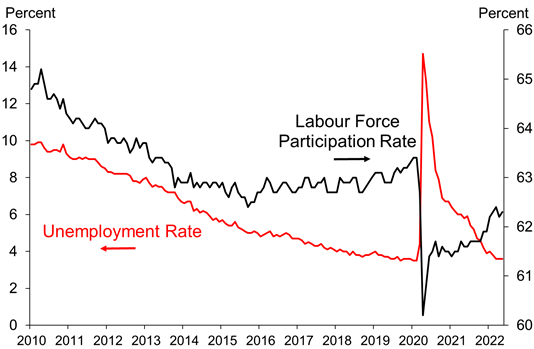The expression "there are three kinds of lies: lies, damned lies, and statistics" has been around almost as long as the word statistics (first coined in 1770, for those wondering). The overall picture does not always look right, even when statistics are carefully checked and correctly reported.

US labour market statistics are particularly exposed to scrutiny and criticism. The pandemic led to unprecedented job losses in the second quarter of 2020. The unemployment rate surged (Chart 1), but some indicators have recently sent mixed signals about the labour market conditions.
This is important as Federal Reserve Chair Powell keeps saying that maximum employment "is a broad-based and inclusive goal" assessed with a "wide range of indicators."
With inflation running at nearly 9%, the highest rate in 40 years, the Fed started raising interest rates in 2022, as US labour markets are close to full employment.
Where have all the good people gone?
For starters, as of end-2021, more than 20 million of the 25 million jobs lost through the pandemic have been recovered, resulting in about 5 million Americans having left the labour force since the beginning of the pandemic.
Being unemployed and not actively seeking work (nonparticipation, in the jargon) may be good or bad for individuals and their families. For instance, some workers may want to spend time raising their children or returning to school. Certainly, however, nonparticipation severely affects society, as, ultimately, it will lead to slower economic growth.
A close look at the statistics reveals that more than 3 million Americans have just retired. The pandemic has accelerated the ageing workforce's retirement pace, as the baby boomer generation came of age and started retiring already towards the end of the 90s. Of course, other factors, such as safety in the workplace and taking care of families at home, are still relevant issues for potential workers. Some individuals who lost their job at the onset of the pandemic searched less intensively for a new occupation as they benefitted from the government's unprecedented expansion of financial support. All the stories about the spiritual awakening of workers suffering a crisis of meaning after the pandemic should be confined to the realm of fictional tales.
Simply put, many people who left the labour force in 2020 do not want a job anymore, and labour markets will remain tight.
Elusive minimum wages
Labour shortages across industries, especially in leisure, hospitality, manufacturing and health services, have led to sharp wage increases in these sectors. Employers of low-wage workers acted in line with President Biden's increase of the federal minimum wage to $15 per hour from the current $7.25 per hour, and raising minimum wages is a bold move.
Economists instinctively oppose minimum wages, leading to job destruction in the standard textbook models. Nobel laureate David Card disagrees with the academic consensus, as in his research, he found "no indication" that a rise in minimum wage costs jobs.
International organizations, including the IMF, World Bank and OECD, echoed Card's results, recommending introducing or increasing minimum wages to raise labour force participation. Outside the US, Hong Kong, Germany and Geneva, Switzerland, for example, introduced minimum wages, and the UK raised the minimum wages a few years ago.
It is early to gauge the impact of the minimum wage recent increase on the US labour market. Most academic research finds that the impact of minimum wages on employment is elusive, but there is clear evidence that minimum wage increases lead to higher wages. This is certainly good news for the worst-paid Americans as their wages have recently risen faster than the wages of the best-paid workers.
Massive retirement, safety concerns, generous government benefits and taking care of own family explain why millions of Americans have been leaving the workforce. This suggests that wage increases may not bring enough workers to hiring companies.
With tight labour markets and high inflation, we expect the Fed to keep raising interest rates this year and next year.


